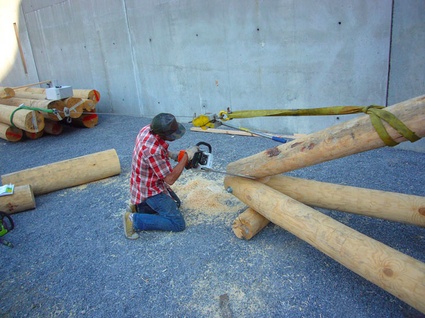From Day 3 of Postopolis, the 5-day blogathon of presentations, interviews and panel talks about landscape and the built environment that ended last Saturday, i’m going to write only about the talk of Benjamin Ball from Ball-Nogues Studio. My first encounter with their work happened 3 years ago through blogs and magazines that were raving about Maximilian’s Schell, a temporary outdoor installation that the Californian duo had installed in the courtyard of Materials & Applications in Los Angeles. I finally got to experience one of their works last Autumn at the Venice Architecture Biennial. Titled Echoes Converge and made of thousands of coloured string catenaries, the installation attempted to create a visual sensation reminiscent of the audio phenomenon of an echo while it kinetically registered the gentle currents of air as visitors experienced its cloud like volume.
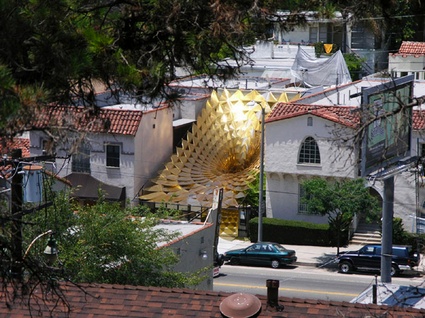
But let’s get back to 2005: their Maximilian’s Schell warped the flow of space with a golden rendition of a celestial black hole. Constructed in tinted Mylar resembling stained glass, the vortex functioned as a shade structure, swirling overhead for the entire summer of 2005. The interior of the immersive installation created a space for social interaction and contemplation by changing the volume, color, and sound of the courtyard gallery. During the day, the canopy cast colored fractal light patterns onto the ground while a sound installation by composer James Lumb lightly rumbled below the feet of visitors. When standing in the center or “singularity” of the piece and gazing upward, the visitor could see only infinite sky. In the evening when viewed from the exterior, the vortex glowed warmly. The piece paid homage to a character played by actor Maximilian Schell in 1979 sci-fi movie The Black Hole.
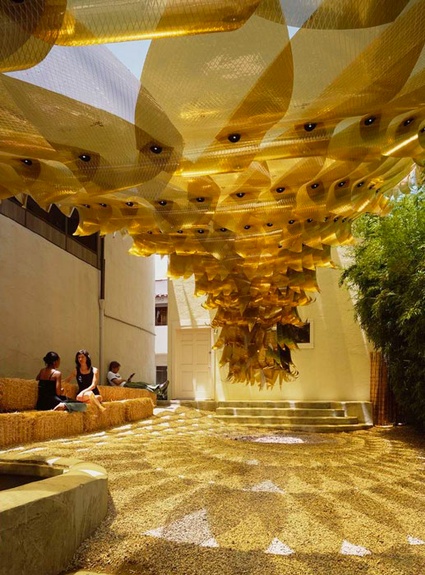
The installation functioned as architecture and sculpture but also as a “made-to-order” product through a unified manufacturing strategy. As though warped by the gravitational force of a black hole, the petals continually changed scale and proportion as they approached the singularity of the piece.
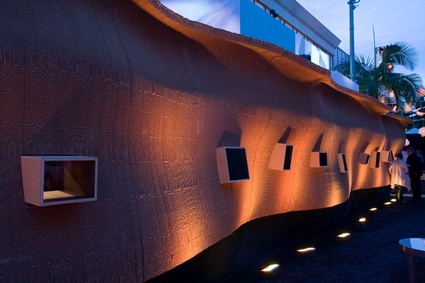
In 2005 Ball-Nogues created the environment for the launch in Beverly Hills of a Tiffany line of jewelry and accessories designed by Frank Gehry (for whom both have worked in the past).
One wall structure, half a block long, curved like the human body and was constructed from 4000 layers of corrugated cardboard sandwiched together. “Peep show” type display windows punctuated the wall, framing compositions of naked models wearing the jewelry. 24 ottomans, no two alike, invited the 600 guests to explore new ways of sitting.
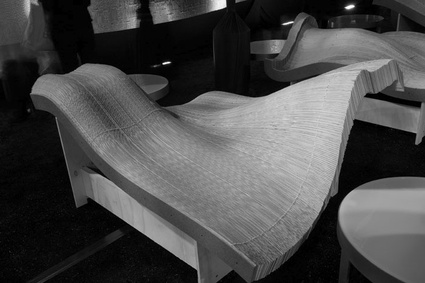
The entire project required laminating over 25,000 strips of curved, industrially cut corrugated cardboard. Incredibly strong and capable of supporting the weight of several people, the cardboard laminates operate more like shells (integrating structure and skin) rather than surfaces – which need the support of a skeletal armature.
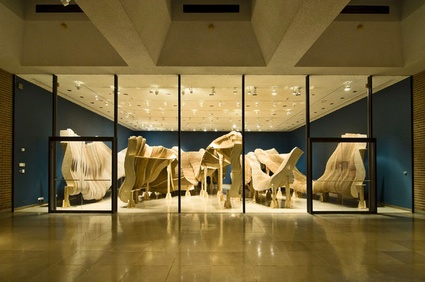
A year later, the LA architects expanded for an installation at the Rice Gallery the cardboard landscapes first developed for the jewelry launch. Visitors were invited to explore Rip Curl Canyon. This rolling playground was used during the exhibition for studying, snoozing, climbing, sliding down the terrain, or making-out in one of the darkened recesses below the cardboard surface. The underside of the installation was turned into a lounge-bar the day of the opening.
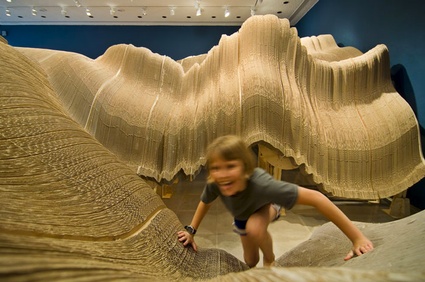
In 2007, Ball-Nogues won a competition to inhabit with a large-scale installation the outdoor courtyard of PS1 Contemporary Art Center. Liquid Sky immersed the viewer in kaleidoscopic patterns of color created by sunlight filtering through an array of translucent, tinted Mylar petals that resemble blossoming flowers of stained glass.
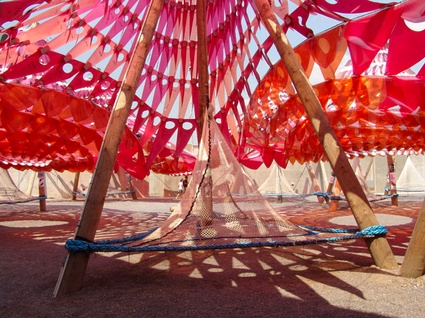
Six towers constructed from untreated utility poles support the surface while providing discrete spaces at their base for relaxing on community hammocks.
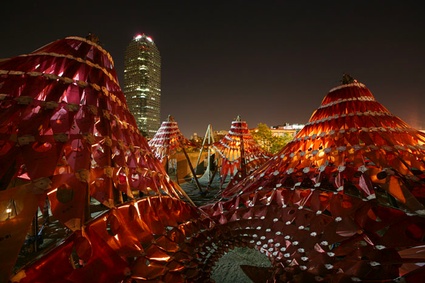
For the adjacent outdoor gallery, the team designed the Droopscape, a slack catenary belly that shifts and flows in the wind, supported by drench towers that periodically soak visitors below with their gravity-induced tip buckets.
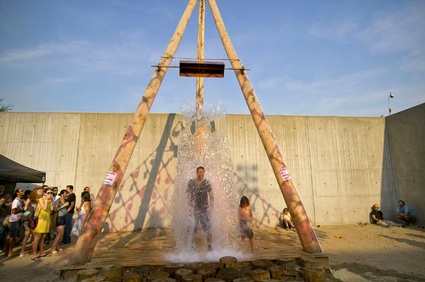 Unseen Current is a navigable billow of fog flowing through Extension Gallery in Chicago. Three thousand hanging strings or “catenaries” totaling 10 miles in length span between the walls of the gallery in precise arrangements. From a distance, the 3D array of catenaries suggests a surface or volume; upon moving to its center, it evokes a rolling fog. A custom software was developed to explore the form of (and generate the plans for) the project. Like a pointillist painting in space inspired by the smoggy sky of Los Angeles, the color of the installation gradates from warm orange to sky blue.
Unseen Current is a navigable billow of fog flowing through Extension Gallery in Chicago. Three thousand hanging strings or “catenaries” totaling 10 miles in length span between the walls of the gallery in precise arrangements. From a distance, the 3D array of catenaries suggests a surface or volume; upon moving to its center, it evokes a rolling fog. A custom software was developed to explore the form of (and generate the plans for) the project. Like a pointillist painting in space inspired by the smoggy sky of Los Angeles, the color of the installation gradates from warm orange to sky blue.
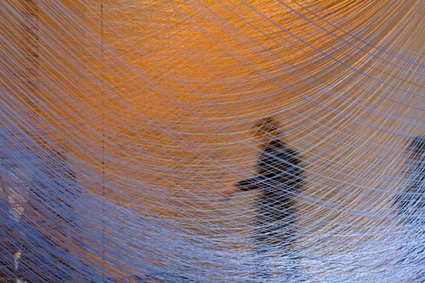 Unseen Current is so light and ethereal that i was almost not there, it was hovering on the verge of an absence turned into an entire atmosphere.
Unseen Current is so light and ethereal that i was almost not there, it was hovering on the verge of an absence turned into an entire atmosphere.
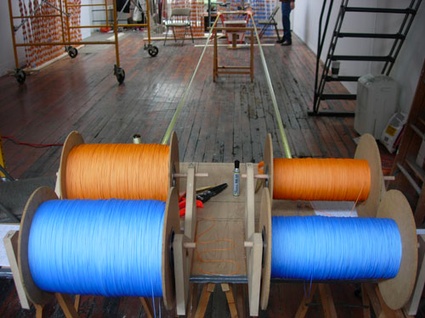
A couple of points gleaned throughout Benjamin’s presentation:
– For Ball, the manufacturing process of their installation is crucial, while making the project they often discover what it will eventually turn out to be.
– there’s a romantization of technology in the design culture.
– there’s a high-tech research behind their work with custom-built software and other sophisticated tools but great attention is also paid to craft and physical labour.
